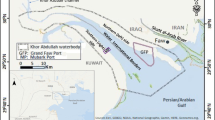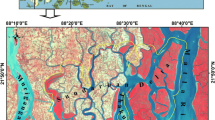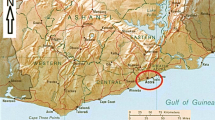Abstract
Hazards from sea cliff instabilities are increasing because of the growing human occupation in coastal areas. Assessment of cliff hazards is very important in order to develop appropriate coastal management plans. In this study, a semi-quantitative heuristic method was developed to assess instability hazard for rocky coasts at Chabahar (Iran) along the northern coastline of the Gulf of Oman. In this method, seven factors affecting cliff instability, including: wave exposure, cliff height, cliff slope, rock resistance, lithology, bathymetry and beach width, were used to calculate an instability hazard index, from which a hazard map was constructed for the study area. Results were validated by statistical analysis of the previous instabilities detected by comparing old and new satellite images. According to the instability hazard class and cliff height, a hazard zone from the top of cliffs was determined within which development is not recommended.











Similar content being viewed by others
References
Afarin M, Hamzeh MA, Negarestan H (2015) Sedimentological and geomorphological classification of Chabahar coastal area (Chabahar-Gawater). J Persian Gulf 6:51–66
Andriani G, Pellegrini V (2014) Qualitative assessment of the cliff instability susceptibility at a given scale with a new multidirectional method. Int J Geol 8:73–82
Arz HW, Lamy F, Pätzold J, Müller PJ, Prins M (2003) Mediterranean moisture source for an early-Holocene humid period in the northern Red Sea. Science 300:118–121
Aydin A, Basu A (2005) The Schmidt hammer in rock material characterization. Eng Geol 81(1):1–14
Barlow J, Gilham J, Ibarra Cofrã I (2017) Kinematic analysis of sea cliff stability using UAV photogrammetry. Int J Remote Sens 38(8–10):2464–2479
Benumof BT, Storlazzi CD, Seymour RJ, Griggs GB (2000) The relationship between incident wave energy and seacliff erosion rates: San Diego County, California. J Coast Res 16:1162–1178
Berger A (1997) Assessing rapid environmental change using geoindicators. Environ Geol 32:36–44
Bieniawski ZT (1989) Engineering rock mass classifications: a complete manual for engineers and geologists in mining, civil, and petroleum engineering. John Wiley & Sons, New York
Brabb, E.E. (1984). "Innovative approaches to landslide hazard and risk mapping". In: Proceeding 4th international symposium on landslides. Canadian Geotechnical Society, Toronto, pp. 307–323
Brown ET (1981) ISRM suggested methods: rock characterization testing and monitoring. Royal School of Mines, London
Budetta P (2013) Landslide Hazard assessment of the Cilento rocky coasts (southern Italy). Int J Geol 7:1–8
Budetta P, De Luca C (2015) Wedge failure hazard assessment by means of a probabilistic approach for an unstable sea-cliff. Nat Hazards 76(2):1219–1239
Budetta P, Santo A, Vivenzio F (2008) Landslide hazard mapping along the coastline of the Cilento region (Italy) by means of a GIS-based parameter rating approach. Geomorphology 94:340–352
Bush DM, Richmond BM, Neal WJ (2001) Coastal-zone hazard maps and recommendations: eastern Puerto Rico. Environ Geosci 8:38–60
Byrne DE, Sykes LR, Davis DM (1992) Great thrust earthquakes and aseismic slip along the plate boundary of the Makran subduction zone. J Geophys Res-Sol Ea 97:449–478
Carter, R.W.G. (2013). "Coastal environments: an introduction to the physical, ecological, and cultural systems of coastlines". Elsevier
Carter CH, Guy DE (1988) Coastal erosion: processes, timing and magnitudes at the bluff toe. Mar Geol 84:1–17
Castedo R, Murphy W, Lawrence J, Paredes C (2012) A new process–response coastal recession model of soft rock cliffs. Geomorphology 177:128–143
Center H (2000) "Evaluation of Erosion hazards". Washington, DC pp205
Coastal Engineering Research Center (CERC) (1984). "Shore protection manual, 4 edn". US Army crops of engineers, Washangton, DC
Cruden D, Varnes D (1996) Landslide types and processes. In: Turner AK, Shuster RL (eds) Landslides: investigation and mitigation, Transportation Research Board special report, vol 247. National Academy Press, Washington, pp 36–75
Dai F, Lee C (2001) Terrain-based mapping of landslide susceptibility using a geographical information system: a case study. Can Geotech J 38:911–923
De Pippo T, Donadio C, Pennetta M, Petrosino C, Terlizzi F, Valente A (2008) Coastal hazard assessment and mapping in northern Campania, Italy. Geomorphology 97:451–466
Del Río L, Gracia FJ (2009) Erosion risk assessment of active coastal cliffs in temperate environments. Geomorphology 112:82–95
Dornbusch U, Robinson DA, Moses CA, Williams RB (2008) Temporal and spatial variations of chalk cliff retreat in East Sussex, 1873 to 2001. Mar Geol 249:271–282
Deere DU, Miller RP (1966) Engineering classification and index properties for intact rock. Air Force Weapons Lab. Tech. Report, AFWL-TR 65-116, Kirtland Base, New Mexico.
Earlie C, Masselink G, Russell P (2018) The role of beach morphology on coastal cliff erosion under extreme waves. Earth Surf Process Landf 43(6):1213–1228
Emery K, Kuhn G (1982) Sea cliffs: their processes, profiles, and classification. Geol Soc Am Bull 93:644–654
Everts, C.H. (1991). "Seacliff retreat and coarse sediment yields in southern California". In: Coastal sediments,. ASCE, pp. 1586–1698
Fall M (2009) A GIS-based mapping of historical coastal cliff recession. B Eng Geol Environ 68:473–482
Fall M, Azzam R, Noubactep C (2006) A multi-method approach to study the stability of natural slopes and landslide susceptibility mapping. Eng Geol 82:241–263
Franklin J, Dusseault M (1989) Rock engineering. McGraw-Hill, New York
Gilham J, Barlow J, Moore R (2018) Marine control over negative power law scaling of mass wasting events in chalk sea cliffs with implications for future recession under the UKCP09 medium emission scenario. Earth Surf Process Landf. https://doi.org/10.1002/esp.4379
Godt J, Baum R, Savage W, Salciarini D, Schulz W, Harp E (2008) Transient deterministic shallow landslide modeling: requirements for susceptibility and hazard assessments in a GIS framework. Eng Geol 102:214–226
González-Díez A, Remondo J, de Terán JRD, Cendrero A (1999) A methodological approach for the analysis of the temporal occurrence and triggering factors of landslides. Geomorphology 30:95–113
Goudie AS (2006) The Schmidt hammer in geomorphological research. Prog Phys Geogr 30(6):703–718
Griggs G, Trenhaile A (1994) Coastal cliffs and platforms. Cambridge University Press, Cambridge
Hanley JA, McNeil BJ (1982) The meaning and use of the area under a receiver operating characteristic (ROC) curve. Radiology 143(1):29–36
Hudson J (1992) Rock engineering systems: theory and practice. Ellis Horwood, New York
Hutchinson J (1998) "Morphological and geotechnical parameters of landslides in relation to geology and hydrogeology, landslides". In: Proceedings of the fifth international symposium on landslides, pp 3–35
Hackney C, Darby SE, Leyland J (2013) Modelling the response of soft cliffs to climate change: A statistical, process-response model using accumulated excess energy. Geomorphology 187:108-121
Jongens R, Gibb J, Alloway B (2007) A new hazard zonation methodology applied to residentially developed sea-cliffs with very low erosion rates, East Coast bays, Auckland, New Zealand. Nat Hazards 40:223–244
Kline SW, Adams PN, Limber PW (2014) The unsteady nature of sea cliff retreat due to mechanical abrasion, failure and comminution feedbacks. Geomorphology 219:53–67
Komar, P.D., and Gaughan, M.K. (1973). "Airy wave theory and breaker height prediction". In: Coastal Engineering pp. 405–418
Komar PD, McDougal W, Marra J, Ruggiero P (1999) The rational analysis of setback distances: applications to the Oregon coast. Shore Beach 67:41–49
Kumar AA, Kunte PD (2012) Coastal vulnerability assessment for Chennai, east coast of India using geospatial techniques. Nat Hazards 64(1):853–872
Lee EM, Clark AR (2002) Investigation and management of soft rock cliffs. Thomas Telford, London, p 382
Marques F (2009) Sea cliff instability hazard prevention and planning: examples of practice in Portugal. J Coast Res 1:856–860
Marques F (2018) Regional scale sea cliff hazard assessment at Sintra and Cascais counties, western coast of Portugal. Geosciences 8(3):80
Marques FMSF, Matildes R, Redweik P (2011) Statistically based sea cliff instability hazard assessment of Burgau-Lagos coastal section (Algarve, Portugal). J Coastal Res 927-931
Marques F, Matildes R, Redweik P (2013) Sea cliff instability susceptibility at regional scale: a statistically based assessment in the southern Algarve, Portugal. Nat Hazard Earth Syst 13:3185
Marques F, Queiroz S, Gouveia L, Vasconcelos M, 2017, December. Slope, scarp and sea cliff instability susceptibility mapping for planning regulations in Almada County, Portugal. In IOP conference series: earth and environmental science (Vol. 95, no. 2, p. 022022). IOP publishing
Martino S, Mazzanti P (2014) Integrating geomechanical surveys and remote sensing for sea cliff slope stability analysis: the Mt. Pucci case study (Italy). Nat Hazards Earth Syst Sci 14(4):831–848
Mathew J, Jha VK, Rawat GS (2009) Landslide susceptibility zonation mapping and its validation in part of Garhwal lesser Himalaya, India, using binary logistic regression analysis and receiver operating characteristic curve method. Landslides 6(1):17–26
Mathew J, Kundu S, Kumar KV, Pant CC (2016) Hydrologically complemented deterministic slope stability analysis in part of Indian lesser Himalaya. Geomatics Nat Hazards Risk 7(5):1557–1576
Montes IM, Santalla IR, García MS, Carrió JA, Velázquez SM, Ortiz DG, Crespo TM (2012) Mapping of landslide susceptibility of coastal cliffs: the Mont-Roig del camp case study. Geol Acta 10(4):439–455
Moore LJ, Griggs GB (2002) Long-term cliff retreat and erosion hotspots along the central shores of the Monterey Bay National Marine Sanctuary. Mar Geol 181:265–283
National Reaserch Center NRC (1990) Managing coastal erosion. National Academies Press, Washington DC, p 182
Naylor LA, Stephenson WJ, Trenhaile AS (2010) Rock coast geomorphology: recent advances and future research directions. Geomorphology 114:3–11
Nunes M, Ferreira O, Schaefer M, Clifton J, Baily B, Moura D, Loureiro C (2009) Hazard assessment in rock cliffs at Central Algarve (Portugal): A tool for coastal management. Ocean Coast Manag 52:506–515
Page WD, Alt JN, Cluff LS, Plafker G (1979) Evidence for the recurrence of large-magnitude earthquakes along the Makran coast of Iran and Pakistan. Tectonophysics 52:533–547
Palmquist R, Bible G (1980) Conceptual modelling of landslide distribution time and space. B Eng Geol Environ 21:178–186
PMO (Ports and Maritime Oragnization of Iran) (2009). "Monitoring and modelling study of some coastal parts of Sistan and Baluchestan and Bushehr proviences: development of a wave climate for the Oman Sea coastaline of Iran, executive summery". Prepared by: W.F. Baird & Associates Coastal Engineers ltd. and Jahad Water and Energyresearch Co.
Prins M, Postma G, Weltje GJ (2000) Controls on terrigenous sediment supply to the Arabian Sea during the late Quaternary: the Makran continental slope. Mar Geol 169:351–371
Queiroz SM, Marques FM (2019) Sea cliff instability susceptibility considering nearby human occupation and predictive capacity assessment. Eng Geol 253:75–93
Regard V, Bellier O, Thomas JC, Bourles D, Bonnet S, Abbassi MR, Feghhi K (2005) Cumulative right-lateral fault slip rate across the Zagros-Makran transfer zone: role of the Minab-Zendan fault system in accommodating Arabia-Eurasia convergence in Southeast Iran. Geophys J Int 162:177–203
Reyss J, Pirazzoli P, Haghipour A, Hatte C, Fontugne M (1999) Quaternary marine terraces and tectonic uplift rates on the south coast of Iran. In: Stewart IS, Vita-Finzi C (eds) Coastal Tectonics: Geological Society. Special Publications 146, London, pp 225–237
Sajinkumar K, Kannan J, Indu G, Muraleedharan C, Rani V (2017) A composite fall-slippage model for cliff recession in the sedimentary coastal cliffs. Geosci Front 8:903–914
Snead, R.E. (1970). "Physical geography of the Makran coastal plain of Iran". Clark Univ Worcester Mass
Sunamura T (2015) Rocky coast processes: with special reference to the recession of soft rock cliffs. P Jpn Acad Series B 91:481–500
Tavoularis N, Koumantakis I, Rozos D, Koukis G (2018) The contribution of landslide susceptibility factors through the use of rock engineering system (RES) to the prognosis of slope failures: an application in Panagopoula and Malakasa landslide areas in Greece. Geotech Geol Eng 36(3):1491–1508
Te Chow V (1988) "Applied hydrology". Tata McGraw-Hill Education,
Teixeira SB (2006) Slope mass movements on rocky sea-cliffs: a power-law distributed natural hazard on the Barlavento coast, Algarve, Portugal. Cont Shelf Res 26:1077–1091
Teixeira SB (2014) Coastal hazards from slope mass movements: analysis and management approach on the Barlavento coast, Algarve, Portugal. Ocean Coast Manag 102:285–293
Thom B (2004) Geography, planning and law: a coastal perspective. Aust Geogr 35:3–16
Trenhaile A (2000) Modeling the development of wave-cut shore platforms. Mar Geol 166:163–178
Turner A, Schuster R (1996) "Landslides: investigation and mitigation: Transportation Research Board". Special report 247, National Research Council, Washington, DC pp.673
Trenhaile AS (2002) Modeling the development of marine terraces on tectonically mobile rock coasts. Marine Geology 185 (3-4):341-361
Trenhaile AS (2005) Modelling the effect of waves, weathering and beach development on shore platform development. Earth Surface Processes and Landforms 30 (5):613-634
Trenhaile AS (2011) Predicting the response of hard and soft rock coasts to changes in sea level and wave height. Climatic Change 109 (3-4):599-615
Varnes DJ (1984) "Landslide hazard zonation: a review of principles and practice". Natural hazards, 3. UNESCO, Paris , 63pp
Viegas, J., Gonçalves, J.P. and Pais, L.A., 2017, October. Rockfall risk assessment along Cliffed coastlines of Algarve, Portugal. In: International congress on engineering and sustainability in the XXI century (pp. 32-46). Springer, Cham
Walkden M, Hall J (2005) A predictive mesoscale model of the erosion and profile development of soft rock shores. Coast Eng 52:535–563
Young AP, Carilli JE (2019) Global distribution of coastal cliffs. Earth Surf Process Landf 44(6):1309–1316
Zêzere JL, de Brum Ferreira A, Rodrigues ML (1999) The role of conditioning and triggering factors in the occurrence of landslides: a case study in the area north of Lisbon (Portugal). Geomorphology 30:133–146
Zweig MH, Campbell G (1993) Receiver-operating characteristic (ROC) plots: a fundamental evaluation tool in clinical medicine. Clin Chem 39(4):561–577
Acknowledgments
The Authors are thankful to the Iranian National Institute for Oceanography and Atmospheric Science (INIOAS) for supporting this work.
Author information
Authors and Affiliations
Corresponding author
Additional information
Publisher’s note
Springer Nature remains neutral with regard to jurisdictional claims in published maps and institutional affiliations.
Rights and permissions
About this article
Cite this article
Gerivani, H., Stephenson, W. & Afarin, M. Sea cliff instability hazard assessment for coastal management in Chabahar, Iran. J Coast Conserv 24, 5 (2020). https://doi.org/10.1007/s11852-019-00726-7
Received:
Revised:
Accepted:
Published:
DOI: https://doi.org/10.1007/s11852-019-00726-7




